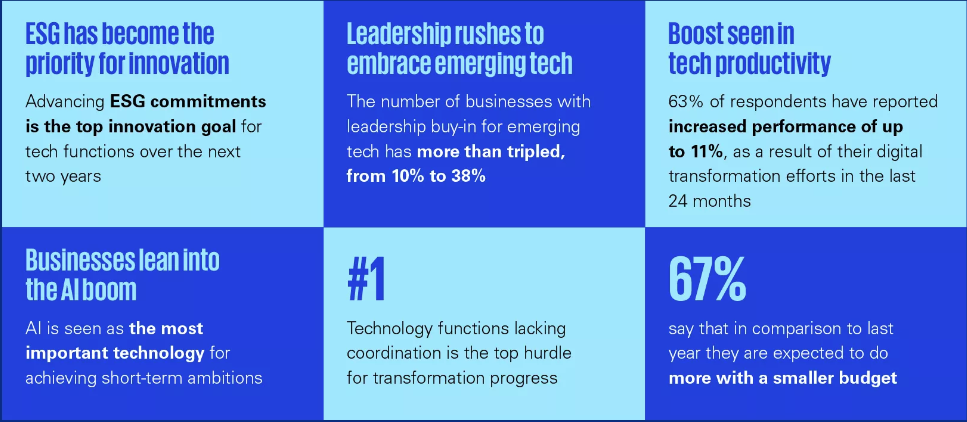How AI and Cloud Technologies Drive Performance and Profitability

In today’s hyperconnected and data-driven world, businesses of all sizes are constantly seeking ways to gain a competitive edge and boost their bottom lines. Two technologies that have emerged as game-changers in this pursuit are Artificial Intelligence (AI) and Cloud Computing.
These transformative investments are not only reshaping industries but also driving performance and profitability to new heights. In this article, we will explore how AI and Cloud technologies work in tandem to elevate business operations and why investing in them is essential for staying ahead in the modern business landscape.
Leveraging AI and Cloud
Ah, AI, that now-famous acronym. As I’ve heard and read, 2023 is apparently the year of AI. Makes me wonder what 2025 will be the year of at the pace large language models are moving.
AI, which you may find better understood as “machine intelligence,” encompasses various techniques and algorithms that enable computers to perform tasks that typically require human intelligence.
This includes tasks such as natural language processing, image recognition, and predictive analytics. AI systems can continuously learn and adapt from data, making them powerful tools for automation and decision-making.
This is similar to generative AI, which uses synthetic data in any form, which includes imagery, video, audio, and written. And if you’re wondering what Generative AI is, just have a play around on ChatGPT, Anthropic, Bing (powered by ChatGPT), or Bard. You’ll catch on fairly quickly. Enjoy!
Cloud Computing is different. This technology or capability provides scalable and on-demand access to computing resources, such as storage, processing power, and software applications, delivered over the Internet.
This can either be on-premise (on-prem) meaning it’s all in-house and not on a public server or you can have it on a cloud server that might be 2,000 miles away from you. You can of course have a mixture being hybrid. It really depends on aspects such as security, how you want to pay for the storage, and the growth of the company.
Cloud services can be categorized into three main models: Infrastructure as a Service (IaaS), Platform as a Service (PaaS), and Software as a Service (SaaS).
Cloud providers manage the underlying infrastructure, freeing organizations from the burden of hardware maintenance and allowing them to focus on their core competencies.
The synergy between AI and Cloud arises from the fact that AI often requires substantial computational resources and access to extensive datasets, both of which can be efficiently provided by cloud platforms.
Cloud computing facilitates the storage and processing of vast datasets required for AI training and execution, making it a natural partner for AI-driven initiatives.
All of this makes it powerful for your business. It can definitely lead to faster time to market, bigger margins, better company profitability, and much more. That’s what I’m going to look at in the subheadings below.
Why are Businesses Investing in AI and Cloud?
KPMG’s Global Tech Report 2023, released earlier in September, had 63 percent of respondents say investments in technologies such as AI and Cloud can increase performance and profitability. And this is one of the biggest surveys I’ve seen on this topic as they interviewed 2,100 execs across every continent apart from Antarctica.
And it appears that business leadership teams are paying attention to the role and impact AI is having. I say this because another stat in this report details how since the 2022 version, the appetite for leadership to embrace emerging tech has more than tripled from 10 percent to 38 percent.
The survey finds that although important technologies have matured and are delivering real value, management challenges continue, ranging from understanding the technology to understanding how to manage the costs and the risks associated with the technologies.
Barry Brunsman, Global Leader, CIO Center of Excellence, KPMG International.

It appears every industry and market you look at, the impact of AI is visible. For example, according to Forbes Advisor the number of UK AI companies has increased by 688% in the last 10 years. And according to the UK Government at the beginning of 2022, one in six UK organisations have embraced at least one AI technology into its tech stack. I’d love to see how much that last figure has grown in the past 18 months since publishing.
Now there is the question of how startups and early-stage companies, such as us at The AI Journal, can utilise these tools to go faster down business roadmaps. IBM found in May 2023 research that the ‘best-in-class companies were getting an average of 13% ROI on AI projects implemented.
I mean it’s not a brilliant result, but at the same time, investments take time. Warren Buffet didn’t become a billionaire till 56. Compounding seems to have the same effect on pretty much any vehicle it gets in. And if your mind is jumping to thinking that’s a good thing, it’s not. Just as I might ask you, do you like surprises and you say yes, I’d say you’re a liar. Because you like surprises you like, the ones you don’t like, you likely call problems.
But without segwaying and dare say putting a negative view on the opportunity at hand, as I never like to look at negatives or how I prefer to say risks, let’s look at the ways these two technologies are enhancing a business, shall we?
Enhancing Operational Efficiency
AI and Cloud technologies are a dynamic duo when it comes to improving operational efficiency. AI-powered automation can streamline repetitive and time-consuming tasks, reducing the margin for human error and increasing productivity.
By leveraging AI algorithms, businesses can automate processes ranging from data entry and customer support to supply chain management and predictive maintenance.
The Cloud, with its scalable infrastructure and on-demand resources, ensures that AI applications have the computational power and storage they need to run efficiently. This allows organizations to optimize their operations without the need for significant upfront investments in hardware or infrastructure.
The result is a leaner and more agile operational framework that can adapt to changing demands.
Data-Driven Decision Making
Data is often hailed as the “new oil” of the digital age, and for good reason. AI and Cloud technologies enable businesses to extract valuable insights from vast datasets that would be impossible to analyze manually.
AI algorithms excel at identifying patterns, trends, and correlations within data, providing organizations with actionable insights. You can then stick this into something like a knowledge graph and bingo, you’re going to likely see a picture of where bad decisions have been made.
It might be spotting invoices that you don’t need to pay, it might be channeled on your Slack you don’t use, it might be for automation you are paying to run that you don’t need, it might be someone in your team you have not communicated or kept up with. You get the picture.
For example, there is a new tool I’ve started using called ‘Sybill’. My god, it’s great. It will automatically join the meeting with you and take note of everything in your call. 10-15 minutes after your call will send you an email and put it in your platform dashboard with an overview. Not only that, it will give you action points, pain points and opportunities of the person you were on the call with, and show you speaking time.
My speaking time was in the 60% range with me instantly looking at it thinking “Shit!” as it was a sales call. Anyone in sales will know how important it is to do as little talking and ask as many questions as possible. At least in most cases. And yes, that includes demos, as my personal opinion is you should be seeing how they use the platform, not telling them about the platform.
The great part about cloud platforms is they offer the scalability and storage needed to manage and process large volumes of data efficiently. With AI-driven analytics, businesses can make data-informed decisions across various functions, from marketing and sales to supply chain optimization.
These insights allow for more accurate forecasting, better resource allocation, and ultimately, improved profitability.
Faster, Scalable Innovation
Innovation is a cornerstone of business growth, and AI and Cloud technologies offer fertile ground for experimentation and development. Cloud platforms provide a range of tools and services that enable rapid application development and deployment, reducing time-to-market for new products and services.
AI, when coupled with the Cloud, facilitates innovation by enabling organizations to create intelligent applications and services. Whether it’s developing chatbots for personalized customer interactions or utilizing machine learning for fraud detection, AI-driven innovation has the potential to revolutionize industries and drive revenue growth.
Empowering Customer Experiences
Customer experience has become a critical factor in business success. Arguably the biggest since the digital shift we’ve witnessed over the past 15 years or so. Which was definitely accelerated by the pandemic.
Do you remember the days when you had to wait in line late at night Christmas Eve Eve shopping at the big shopping center for that Christmas Present for your kid (I know because my parents told me about it), or knew your banking clerk to get a business loan, or go into a Blockbuster on a Friday evening hoping they had a copy of the film you want to watch?
Yeah, a lot of that has gone now. And with it, the customer experience has massively changed. Not gone, but changed. And AI and Cloud technologies can play a pivotal role in delivering exceptional customer experiences.
AI-driven chatbots and virtual assistants offer immediate support to customers, improving response times and reducing service costs. It’s what you’re seeing powered by the large language models at the moment, such as Bard, Anthropic, and of course, ChatGPT.
According to the 2023 KPMG Global Tech report, customer experience is a top priority for businesses in 2023. AI-powered chatbots and virtual assistants can provide immediate support to customers any time of the day or week, improve response times, understand the customers to know how to best speak with them, and reduce service costs. Won’t be long until you’re having a full-blow conversation with AI on the phone trying to get money back for that flight you missed that wasn’t your fault, for example.
Cloud platforms ensure the scalability and reliability required to deliver consistent and responsive customer experiences across digital channels. And this leads to a key metric, repeat purchases. As any experienced marketer or salesperson will tell you, it’s a hell of a lot easier in most cases to get a repeat customer.
In fact, Constant Contact found back in July this year that repeat customers have a sixty to seventy percent chance of buying. In addition to that, the National Law Review found that it costs five times more to acquire a new customer than keep a current customer.
With AI-powered personalization, businesses, such as yours, can tailor their offerings to individual customer preferences, enhancing satisfaction and driving loyalty. Satisfied customers are more likely to make repeat purchases and become brand advocates, positively impacting profitability.
Cost and Spend Optimisation
Efficient cost management is essential for maximizing profitability. AI and Cloud investments can help organizations optimize costs in several ways. Cloud computing offers a pay-as-you-go model, eliminating the need for large upfront capital expenditures on IT infrastructure. This cost-effective approach allows businesses to allocate resources more efficiently, ensuring that technology investments align with actual usage.
AI-driven predictive analytics can assist companies in optimizing their supply chain, inventory management, and resource allocation. By minimizing waste and reducing operational inefficiencies, businesses can improve their bottom line and overall profitability.
Competitive Advantage
In today’s fast-paced business landscape, maintaining a competitive edge is essential. Organizations that strategically invest in AI and Cloud technologies are likely to be better positioned to adapt to market changes, innovate rapidly, and meet evolving customer expectations.
AI and Cloud can empower businesses, such as yours, to deliver unique products and services, create personalized experiences, and respond quickly to emerging trends. This agility and innovation can translate into a sustainable competitive advantage and long-term profitability.
Security and Compliance
While AI and Cloud offer numerous benefits, they also bring forth security and compliance challenges. Fortunately, AI and Cloud technologies provide tools and solutions to address these concerns effectively.
AI can enhance cybersecurity by identifying and mitigating threats in real time. It’s important as I mention below how cloud providers invest in these measures, that your own business invest in these measures. A great way of doing it is having a best practice guide.
Milk and Honey’s Manuel Huttl explained when I was on a panel with him at PRCA’s International Summit how they have guidelines around the use of AI. Awesome to hear and would recommend any company have one, even if its a rough outline, its a start.
Angles such as data encryption, identity and access management, having data privacy in place, auditing software so API’s are safe and not leaking data, having a disaster recovery procedure or outsourcing to a qualified business, vendor assesments to make sure the tool or business you are using meet your criteria. Could write a whole article about how important these measures will be in the future.
Cloud providers invest heavily in security measures and compliance certifications, allowing businesses to leverage robust security features without the burden of managing them in-house. By ensuring the security and compliance of their AI and Cloud deployments, organizations can safeguard their reputation and protect against potential losses.
Your Competitive Advantages with AI and Cloud
By enhancing operational efficiency, enabling data-driven insights, fostering innovation, improving customer experiences, optimizing costs, and ensuring a competitive advantage, AI and Cloud investments have become essential for businesses seeking to thrive in the digital age.
As the business landscape continues to evolve, organisations will likely have to embrace the synergy of AI and Cloud to remain competitive and be the winner of increased business. There have been examples of this in the past where companies that don’t make the leap fail. Similar to how Siebel Systems was outpaced and put out of business in 2006 by the digital trend of digital CRMs that Marc Benioff envisioned with Salesforce.
Sure, Salesforce made a tonne of mistakes with Marc’s writing in his book ‘Behind the Cloud’ how the business nearly went bankrupt during the dot com boom era. But now they are, in my opinion, one of the best-performing businesses alongside another company I admire such as ServiceNow.
My firm belief is those who strategically invest in these technologies will be better equipped to navigate the challenges and opportunities of the digital era, ultimately realizing increased performance and profitability.





